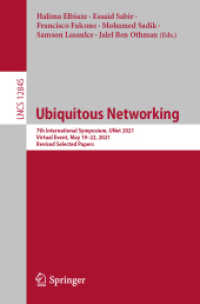- ホーム
- > 洋書
- > 英文書
- > Politics / International Relations
Full Description
Modern trends in geopolitics have raised serious questions about the future global and regional architecture of the world system. In the case of the Eurasian Economic Union, these questions bring up important issues for debate: What is the Eurasian Economic Union? What theoretical concepts could be applied for modern Eurasian integration? Why is the Eurasian Economic Union forming? Most importantly, what prospects does this Union have in the framework of the modern geopolitical situation?
This book explores the process of Eurasian integration in the modern global world. The creation of the Eurasian Economic Union has become a topical issue in modern Russian foreign policy. Neo-Eurasianist ideas can be viewed as a geopolitical basis and rationale for the Eurasian Economic Union that may constitute an integrational structure, consolidating the post-Soviet area and neighboring regions. This book argues that Eurasia is a region representing an organic integrity due to close mentality, common and centuries-long history, common language of international communication, a multitude of economic ties, and an identical level of technological development across all countries within the post-Soviet area. Yet, advancement of the Eurasian integration idea into practical implementation should have new objective suppositions as well. These are defined by the contemporary economic, political, and ethno-cultural processes in the post-Soviet space.
Contents
Chapter 1. New approaches to analysis of the "Post-Soviet area" phenomenon
Chapter 2. Integration and disintegration as major trends in the Post-Soviet area
Chapter 3. The main integration models within the Post-Soviet area
Chapter 4. The notion "Eurasia": the problem of identification of the region
Chapter 5. The Eurasian idea in contemporary interpretation
Chapter 6. Contemporary Eurasian integration in experts' estimates
Chapter 7. The Foundation of the Present Eurasian Integration in International Law
Chapter 8. The main interests and expectations of the member-states of Eurasian Economic Union
Chapter 9. Russian Geopolitical Interests in the Eurasian Economic Union
Chapter 10. The strategy of Eurasian Integration: Regional and Global Dimensions






